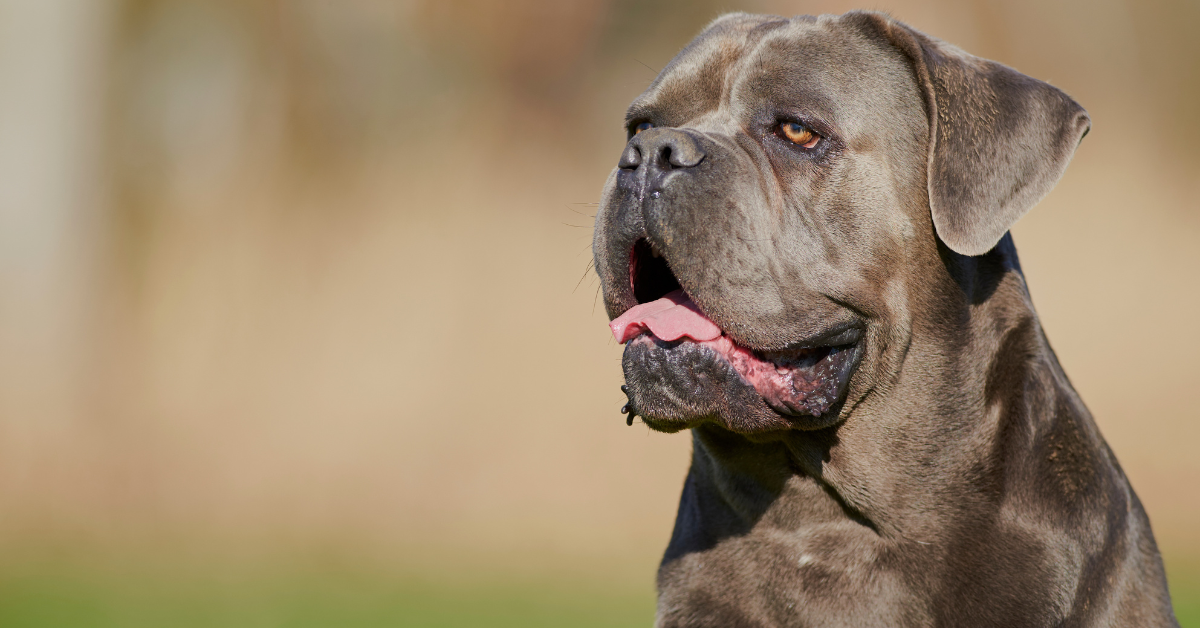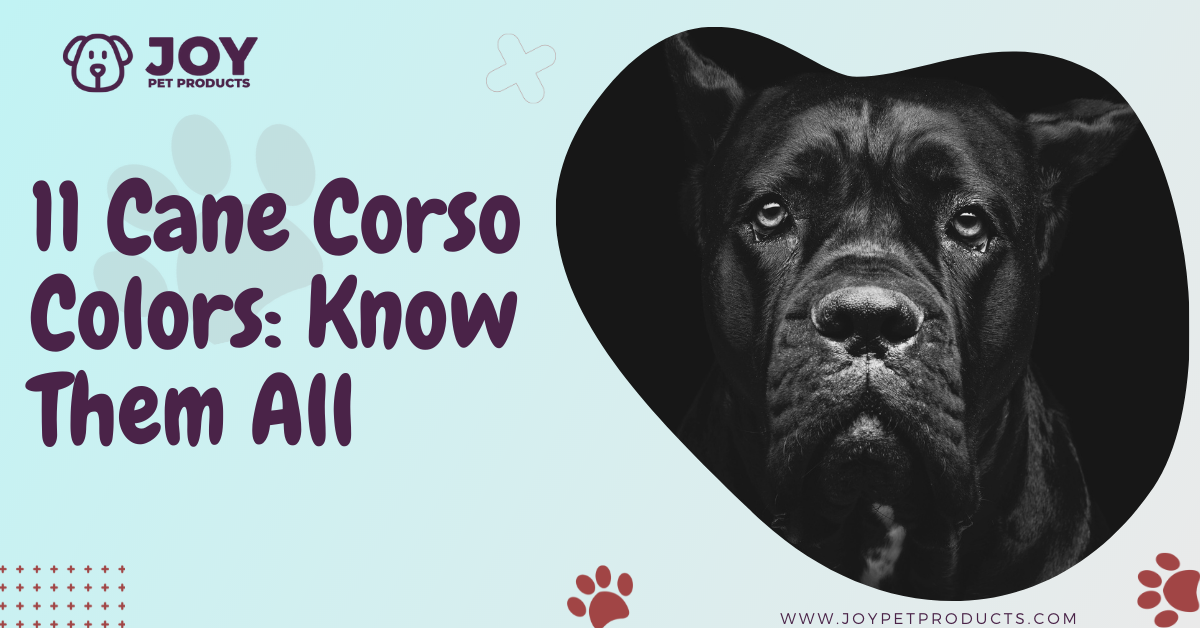If you are looking for a protective and affectionate companion dog, explore the possibility of adopting a Cane Corso.
A Cane Corso is a majestic dog breed that’s intelligent, watchful, and has an imposing appearance. The breed is easy to train, playful and decent around children and strangers. Cane Corso has a short and shiny coat type that comes in various colors.
This dog breed is originally from Italy and serves both as a companion and a guard dog. Earlier, Cane Corso’s assisted hunting game large animals and herding dogs.
Some standard Cane Corso colors are recognized by the American Kennel Club (AKC). But you are also bound to find dogs with rare colors explicitly bred for aesthetic reasons.
The article will take you through the different colors of Cane Corso’s and how it affects their health.
Cane Corso’s With Standard Colors
Now that we have come across what is a Cane Corso breed. Let’s know in finer detail about the different colors and their uniqueness.
1. Black Cane Corso

Black is a beautiful-looking, majestic color shade, most sought after in Cane Corso’s. The color black takes the whole imposing appearance of the dog to the next level. That is a notable feature if you want to keep intruders away.
The two primary pigments responsible for dogs’ color are eumelanin (black) and phaeomelanin (red). The black in Cane Corso’s results from eumelanin.
It is the genes that control the pigments mentioned above. For example, a dog with a homozygous dilution gene can turn black to blue. But in the case of a black Cane Corso, the gene is not homozygous for dilution, and thus the coat color remains an intense black.
A black Cane Corso is further categorized by black nose and brown eyes.
2. Fawn Cane Corso

Cane Corso’s with a light brown tan to creamy shades fall under the fawn color category. They also have a light black or gray mask around their eyes. The puppy must receive the red and dilution gene from both its parents for a fawn-colored coat.
Fawn-colored Cane Corso’s have been around for centuries. People popularly used them for hunting as their coat color allowed them to blend with the surroundings easily.
3. Gray Cane Corso

The color gray in a Cane Corso results from the recessive dilute gene that limits the production of eumelanin (black). Therefore, both should carry this gene for the puppy to be born gray.
The gray-colored coat could either lighten or further darken as the puppy grows. Slight variations in the shade are acceptable.
The gray Cane Corso color is often referred to as the blue Cane Corso as well. The confusion arises due to the naming conventions used by AKC and Federation Cynologique Internationale (FCI). So do not get confused when a pet owner refers to their dog as blue. These colors are used interchangeably when it comes to Cane Corso’s.
4. Red Cane Corso

The red Cane Corso’s come in a range of different shades and hues. One of the primary pigments, phaeomelanin (red), is responsible for the red-colored coat. But depending on the genes, the red can take the form of deep mahogany while others could have a pale champagne-colored coat.
In addition, like the fawn Corso’s, the red Corso’s have a black/gray mask around their eyes. Some red Cane Corso puppies could also have saddle markings that might fade as they grow.
5. Black Brindle Cane Corso

A black brindle Corso is distinguished with a red or brown base color with black-colored stripes on top. The brindle pattern and coloration are famously known as tiger stripes or as ‘tigrato’ in native Italy.
A puppy needs to have a red gene for the base color and a diluted gene from one of its parents to have a black brindle pattern. Further, the design will vary significantly from one dog to another.
Compared to solid-colored dogs, brindle Cane Corso’s have a longer life expectancy.
6. Gray Brindle Cane Corso

A gray brindle Corso is distinguished with a brown base color with gray or blue stripes on top. A gray brindle is a rare color compared to its solid gray counterpart or even the black brindles.
According to a study of the inheritance of coat color in Cane Corso’s, two grey brindle parents could produce 50.9% of grey brindle offspring.
The coat of the gray brindle Corso may appear blotchy. Do not worry, though; this is an entirely acceptable physical trait.
7. Chestnut Brindle Cane Corso

This Cane Corso is a rare type belonging to the brindle variety. It has a red or a brown tone for its base color. On top, the stripes are of a reddish-brown color. The brindle coloration is similar to that of a black brindle. In some cases, you might even find it hard to differentiate between the two.
It could get challenging to find a chestnut brindle Cane Corso if that is the color you especially want. It is because the chestnut brindle is a color that depends on their parents and the gender of the puppy.
8. Rare Cane Corso Colors

Apart from the standard colors, Cane Corso’s also come in a few ‘rare’ colors. Unfortunately, the AKC does not recognize these colors. Instead, the colors get tagged as ‘rare’ from breeders who breed these dogs only for their looks.
As a pet owner, if you are considering a rare Cane Corso color, it is essential you make an informed decision. Breeders could sell these dogs at exorbitant prices, and their health could also be an issue.
Let us look at some of the rare colors found in Cane Corso’s.
9. Formentino Cane Corso

The Formentino Cane Corso is also referred to as the blue fawn. The word ‘Formentino’ comes from an Italian word used to describe the color of fermented wheat.
This Corso is distinguished by a coal-colored coat, a blue nose, and a mask around the eyes. It may also have gray patches over its back and shoulders.
You might also come across Corso’s with a solid Formentino color due to breeders following improper breeding practices. As Formentino is a dilute color, the dog will be more susceptible to skin conditions. They will also have a lower life expectancy than the brindle Cane Corso’s.
10. Chocolate or Liver Cane Corso

You might end up confusing chocolate or liver-colored Cane Corso with their red Corso cousins. It is due to the similarity in their coat shade. But you can spot differentiate the chocolate Cane Corso by the color of their nose and skin around their eyes. These parts usually have a pink or purple undertone.
According to many kennel organizations, this color is considered a fault. The belief is that breeders produce this rare color only for the high value it can fetch with no regard to the dog’s health.
If you find chocolate or liver-colored Cane Corso, enquire about its parents and the breeding process. You should not pay a higher price just for the color of the coat.
11. Isabella Cane Corso
This is another rare color of Cane Corso that is considered a fault by most kennel organizations. These dogs are bred with little to no regard for their health and temperament.
The Isabella Cane Corso has a light liver-colored coat. They often have green or blue-colored eyes. The skin around their eyes, nose, and lips lack pigmentation and usually has a pink hue.
With the Isabella again being a diluted color, it is more prone to skin conditions, especially conditions like Color Dilution Alopecia.
Does the Color of the Cane Corso Matter?
The straightforward answer to this question is yes. The color of the Cane Corso matters as it gives you an idea about their life expectancy and health issues they might deal with in the future.
For example, black or gray Cane Corso’s rarely live beyond eight to nine years. In comparison, black brindle Cane Corso’s have an average life expectancy of 10 years.
Dogs bred specifically for their color are more susceptible to skin diseases. Pale-colored dogs like Isabella fall into this category. Some of the prominent health issues that you will find in rare-colored Cane Corso’s are:
- Eye Conditions: Eye conditions like subluxated pupils and microphthalmia might be found in Formentino, Isabella, and Chocolate Corso’s. With age, their vision will deteriorate, and they could also lose their eyesight altogether.
- Color Dilution Alopecia: This condition leads to hair loss and skin irritation. Isabella is most prone to this condition.
- Skin Cancer: Cane Corso’s are prone to cancer like any dog breed. But paler Corso’s have a higher probability of developing skin cancer. Lack of pigments makes their skin sensitive to the sun. If issues such as sunburn skin infection are left untreated, they could lead to skin cancer.
Summary
Bringing a Cane Corso home is a huge responsibility. You need to take care of the dog and ensure it can enjoy a certain quality of life.
Take time to understand different Cane Corso colors and their effect on their health. This knowledge is also necessary to avoid breeders who can con you into shelling big money on the pretext of ‘rare’ colors.
Cane Corso’s are fiercely loyal, protective, and intelligent. They would make a great addition to your family. Keep in mind the information provided above when you are ready to bring the pup home.
Elena Gherman is a highly skilled and knowledgeable animal care expert. At the start of her career, she gained practical expertise with multiple animals. In addition to that, she works as a DVM veterinary editor for Joy Pet Products, which focuses on offering reliable information on pet health and wellbeing. She meticulously reviews each piece of writing before it is published to make sure pet owners get the most precise and updated information possible.
